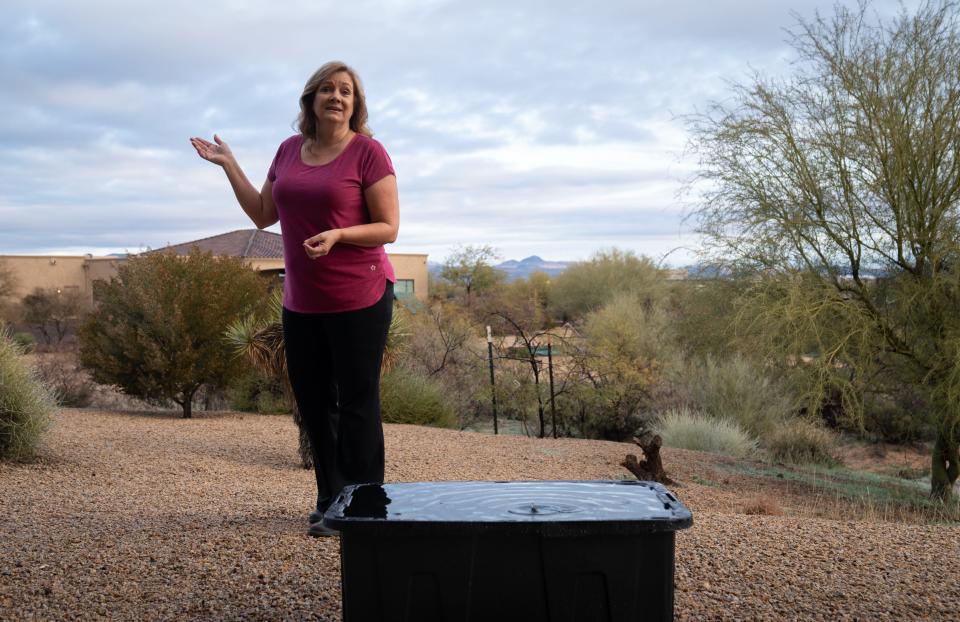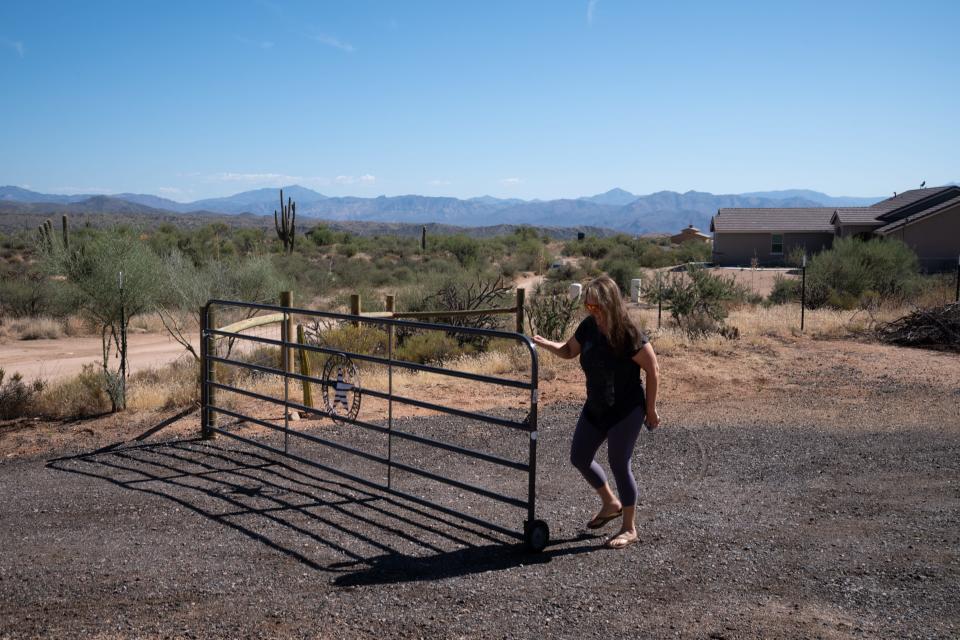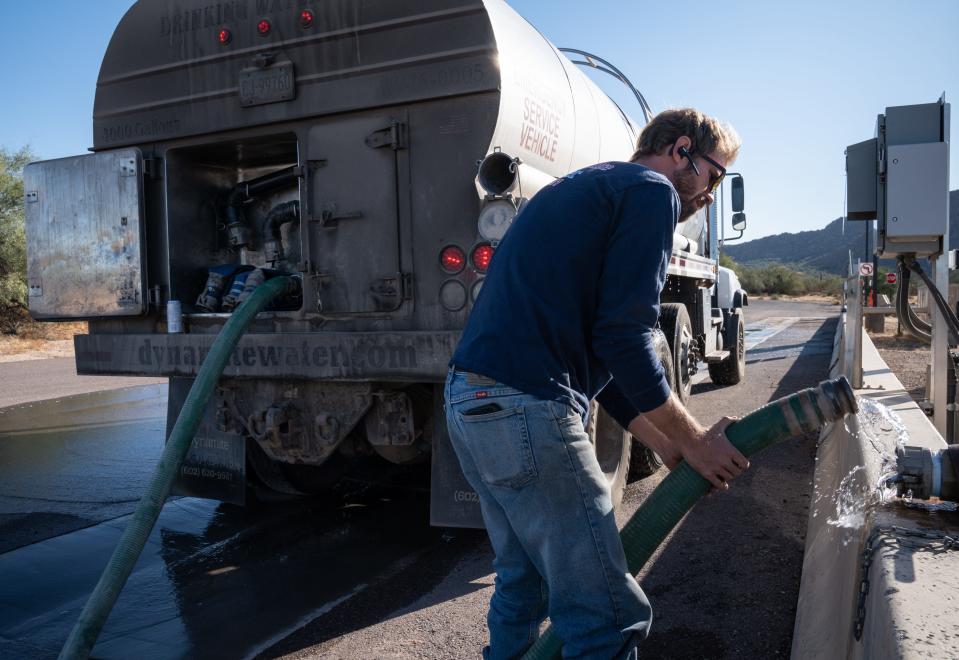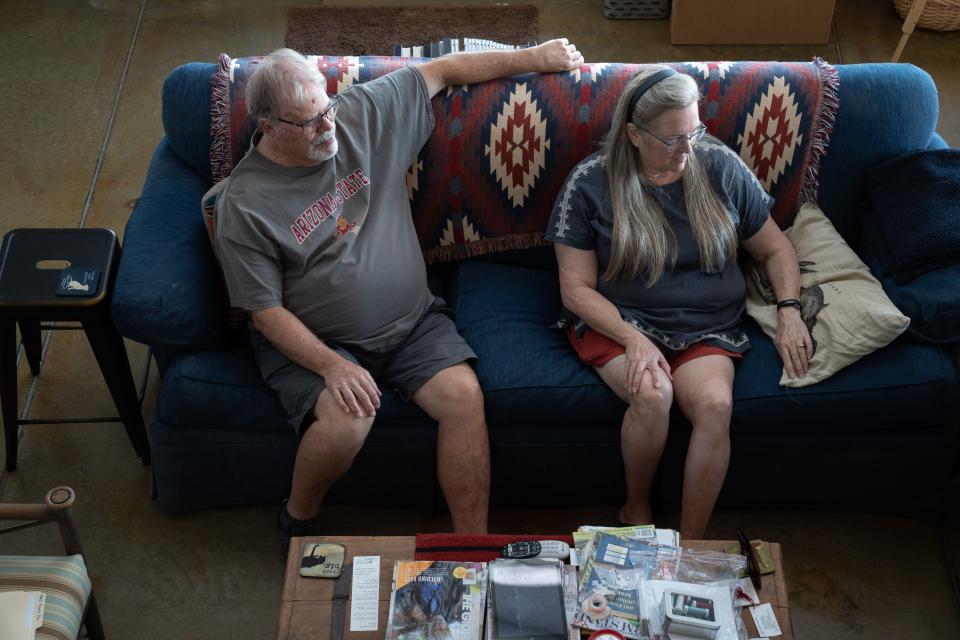Rio Verde Foothills residents rejoice over water, but say challenges remain
Rio Verde Foothills residents are reveling as water trucks once again traverse the community's dusty roads with a stable, if temporary, water supply.
Commercial water haulers have made deliveries to dozens of homes since Monday when the unincorporated neighborhood's short-term water solution launched after months of uncertainty. The community was left without a reliable source of water after neighboring Scottsdale cut off its supply in January.
That left residents reliant on unstable, expensive sources of water. Now, most have access to water from Scottsdale's standpipe through a series of agreements between the community's standpipe district, the city and water utility Epcor.
Karen Nabity collected rainwater off her roof for non-potable uses such as flushing toilets amid the crisis. She was one of the first in the community to receive a water delivery on Monday and said she was relieved to see a hauler filling her underground water tank.

"I went out there and hugged that man," she said. "It was wonderful."
But the area's water woes are far from over, residents say. While they have access to standpipe water for now, the arrangement is temporary. By the end of 2025, the community must find a long-term water supply solution.
Currently, service to the community through a long-term arrangement with Epcor is the main option on the table. Epcor is regulated by the Arizona Corporation Commission, so that entity first must approve its application to serve the community permanently. It's unclear exactly how long the process might take, according to commission staff.
Even if Epcor's application is approved, company officials said it could take the utility an additional 24 to 36 months to get a long-term supply of water to Rio Verde Foothills.
That puts it on a tight timeline to have a permanent supply in place before the standpipe district's temporary agreements end and leaves homeowners like Linda Vinson, who took showers at the gym for months, with "guarded optimism."
Following the months of uncertainty: Rio Verde Foothills residents will see water on Monday
Meanwhile, many residents tacitly acknowledge that the interim solution is far from perfect. When state lawmakers established the standpipe district in June via emergency legislation, they set a restriction on how many homes it could serve. That means not everyone who wants to be a member of the standpipe district ultimately gets a full-time spot.
"There's still some people out here that need water that are not in that district," said resident Wendy Bobbitt. "So, what are they going to do?"
And, although bills have fallen from summer highs, most residents say they are still paying more than they were before the January cutoff.
"There is a lot of concern in the community about the pricing," said resident Larry Wolff. "It's double what we were paying a year ago, but it's a lot less than what we were paying throughout this year."
Haulers say that the costs have simply gone up. Scottsdale is taking more money at the standpipe than it was before gas and other essentials are more expensive, and employees need to make enough to feed their families.
"It costs a certain amount," said John Hornewer, a Foothills resident and owner of Rio Verde Foothills Potable Water. "That's just what it is."

Who got a spot in the standpipe district?
In an attempt to place limits on the new governmental entity, state lawmakers restricted the community's standpipe district to only serving 750 residences.
While fewer than 750 homes in the neighborhood are estimated to be entirely reliant on hauled water, some residents have wells that function poorly and still need to haul water in often. Others have mostly reliable wells but haul water in occasionally and want access to a stable supply. Some residents are entirely reliant on wells but want to have the option of hauling in case something goes wrong, given the area's spotty and already stressed aquifer.
Standpipe district leaders ultimately chose to prioritize people who had accounts with the community's main private water haulers prior to the January shutoff. They reserved about 50 slots to use in a rotating schedule of water fills for households not entirely dependent on hauled water.
All homeowners currently residing in the community will be included in any long-term solution approved by the Arizona Corporation Commission. In the meantime, residents not in the standpipe district will still be able to access hauled water anytime from other, less stable sources for a greater cost, as the entire community has done since January.

'The cost of doing business'
Most residents are reporting slight drops in their bills — but not enough to bring the cost of water back down to what it was before the shutoff.
There are two main factors contributing to costs, haulers say. First, the cost of water has simply gone up. Scottsdale was charging Rio Verde Foothills residents $7 per 1,000 gallons of water before the shutoff in January. Now, the city gets $1,000 per month plus $17.96 per 1,000 gallons of water from the standpipe district.
Haulers have also increased their rates to make up for inflation and other expenses. Damon Bruns, owner of Dynamite Water and a Foothills resident, said price increases have hit "across the board" in recent years. His business is impacted, too, he said.
"It's just the cost of doing business," he said, adding that he hasn't heard much negative feedback from customers.
Foothills resident Wolff said he doesn't think the community should "get up in arms" with haulers before they have a chance to explain the expenses.
"Nobody is opposed to them making a profit," he said.
Still, there's no denying that the haulers' rates have increased, he said, and some in the community are concerned.
Bruns and Hornewer both say there are also some additional administrative duties required under their new contracts with the standpipe district.
The district's board members are committed to closely tracking how water from the standpipe is used to ensure that the community is complying with the terms of its agreements. Hornewer said that means he has to keep tabs on his customers' individual meters and audit in a way he didn't before.
It poses logistical challenges for households on shared tanks and wells, he said, some of which may be standpipe district members and others that might not.
"Honestly, I still don't know how this is going to work," he said, adding that it's a "nightmare."
Hornewer said there's "not a chance" that the cost of hauled water will go down to what it was before the shutoff.
Still, he and Bruns both said that costs may rise or fall depending on the community's long-term arrangement with Epcor, assuming that the Corporation Commission approves the utility's request to serve the Foothills.
"I don't know what the future holds," Bruns said. "I think a lot of that depends on Epcor."

A community hopeful, but changed
Bruns said every Foothills resident is "thrilled to death" that the water is back on.
"I think everybody is just thankful that we have assured water," he said.
But the events of the past 10 months still linger, residents say.
During a brief morning rain on Monday, Nabity said she ran outside to put out buckets to collect rainwater.
"It's habit now," she said. "I didn't even think twice about it."
She said her community's struggle has "totally changed" the way she and her family see water.
"It's a finite resource, and people need to understand that," Nabity said.
The community was long torn between those who supported a water taxing district that county supervisors voted down last year and those who wish to see a long-term solution with Epcor. Now, nearly every resident has united in support of the community's standpipe district.
Standpipe district leaders did an "absolutely incredibly amazing job" in securing short-term water for the Foothills, Wolff said.
Past news on Rio Verde Foothills: Close to short-term solutions, tough decisions remain
Rio Verde Foothills was in some ways better equipped than most communities to encounter water problems, said Vinson, because it is close to a major urban area and is relatively affluent. But the ordeal has changed how she views her home, which was designed by her husband, an architect. Vinson said she expected to stay in the house until she was carried out "feet first."
Over the past year, though, she and her husband have had numerous conversations about selling, she said.
"We had more than one conversation about that," Vinson said. "We'll see. We'd like to stay here."
Sasha Hupka covers Maricopa County, Pinal County and regional issues for The Arizona Republic. Do you have a tip about a hauled water community? Reach her at sasha.hupka@arizonarepublic.com. Follow her on X, formerly Twitter: @SashaHupka. Follow her on Instagram or Threads: @sashahupkasnaps.
This article originally appeared on Arizona Republic: As Rio Verde Foothills residents rejoice over water, what comes next?

